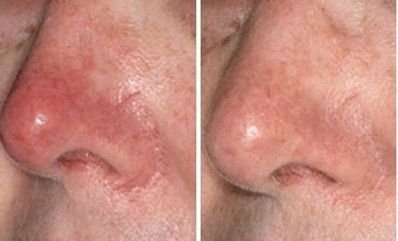4 reasons to consider redness removal:
1. Improve your skin appearance
2. Reduce the risk of developing complications
3. Avoid developing future pigmentation
4. Flawless clear skin at any time of the day

Rosacea removal
Couperose or Rosacea?
"Couperose" is the French word for the chronic inflammatory skin disorder rosacea. The term “couperose skin” is sometimes used to describe skin that’s showing signs of rosacea.
Rosacea is a chronic but treatable skin condition that primarily affects the central face, and is often characterized by flare-ups and remissions. Although rosacea may develop in many ways and at any age, patient surveys indicate that it typically begins any time after age 30 as flushing or redness on the cheeks, nose, chin or forehead that may come and go. Studies have shown that over time the redness tends to become ruddier and more persistent, and visible blood vessels may appear. Left untreated, inflammatory bumps and pimples often develop.
Although rosacea can affect all segments of the population and all skin types, individuals with fair skin who tend to flush or blush easily are believed to be at greatest risk. The disorder is more frequently diagnosed in women, but tends to be more severe in men. There is also evidence that rosacea may tend to run in families, and may be especially prevalent in people of northern or eastern European descent.
Rosacea can be classified into four subtypes depending on the symptoms. People often experience symptoms of multiple subtypes:
-
Erythematotelangiectatic rosacea is characterized by redness and flushing of the central part of the face. It often leads to telangiectasia, or visible blood vessels in a spiderweb pattern.
-
Papulopustular rosacea leads to breakouts of pimples and pustules.
-
Rhinophyma rosacea is a relatively rare form of rosacea that causes the skin on your nose to thicken. It’s more common in men than in women.
-
Ocular rosacea is associated with redness and inflammation in and around the eyes.
Diagnostic Signs of Rosacea
The presence of either of these signs is diagnostic of rosacea.
-
Persistent Redness
Persistent facial redness is the most common individual sign of rosacea, and may resemble a blush or sunburn that does not go away. -
Skin Thickening
The skin may thicken and enlarge from excess tissue, most commonly on the nose
Major Signs of Rosacea - the presence of at least two of these signs is diagnostic of rosacea.
-
Flushing
This facial redness may be accompanied by a sense of heat, warmth or burning comes and goes, and is often an early feature of the disorder. -
Bumps and Pimples
Small red solid bumps or pus-filled pimples often develop. While these may resemble acne, blackheads are absent and burning or stinging may occur. -
Visible Blood Vessels
-
Eye Irritation
In many rosacea patients, the eyes may be irritated and appear watery or bloodshot, a condition commonly known as ocular rosacea. The eyelids also may become red and swollen, and styes are common.
Secondary Signs and Symptoms - these may appear with one or more of the diagnostic or major signs.
-
Burning or Stinging
Burning or stinging sensations may often occur on the face. Itching or a feeling of tightness may also develop. -
Swelling
Facial swelling, known as edema, may accompany other signs of rosacea or occur independently. Raised red patches, known as plaques, may develop without changes in the surrounding skin. -
Dryness
The central facial skin may be rough, and appear scaly despite some patients complaining of oily skin
In rare cases, rosacea signs and symptoms may also develop beyond the face, most commonly on the neck, chest, scalp or ears.
Read more about rosacea, causes, triggers, signs and symptoms on the National Rosacea Society website.
The American Academy of Dermatologists states that lasers used to treat visible blood vessels have excellent results. Patients see a 50 to 75 percent reduction in their symptoms after one to three treatments that can last up to five years.
Couperose/Rosacea Removal
STARTS FROM $150 PER SESSION
LASER ALEXANDRITE $150 (1 session)
LASER ND: YAG $150 (small or medium area)
IPL FACE $250 (1 session)
IPL FACE $660 ( 3 sessions)

Cheeks Before After

Cheeks Before After

Cheeks Before After

Nose Before After
Contact
Details
Address
76 W Brighton Avenue, Suite #66, Brooklyn, NY 11224
Phone
929 884 8080
929 218 5888
Hours of Operation:
Mon-Sun 9am-7pm
.png)